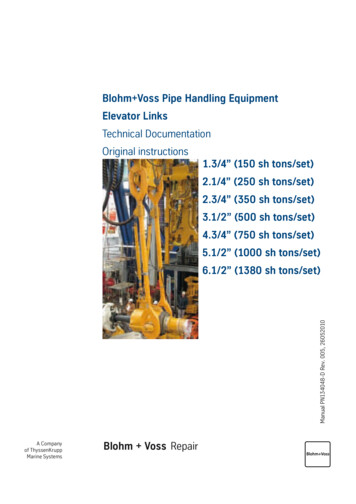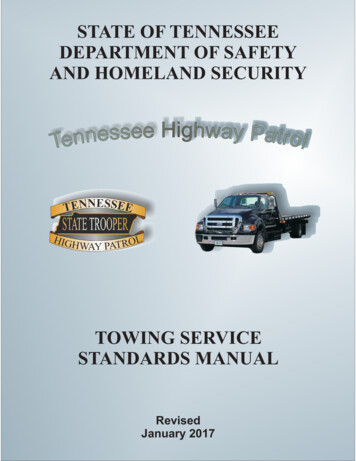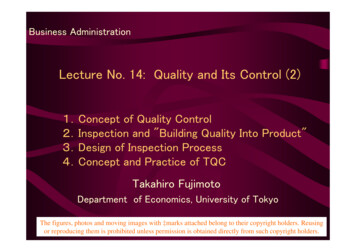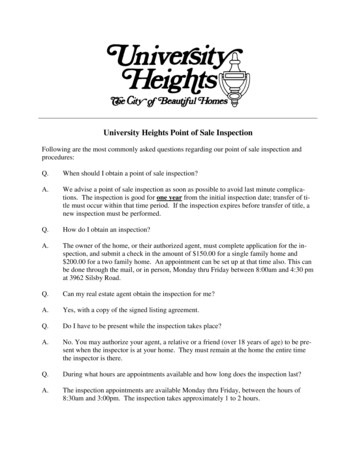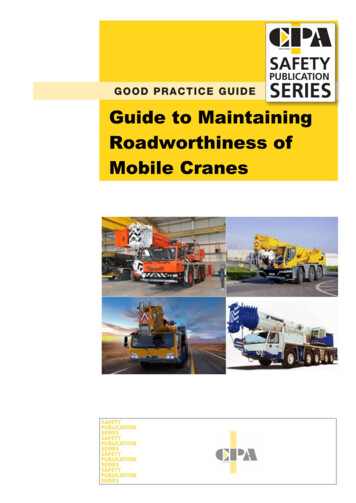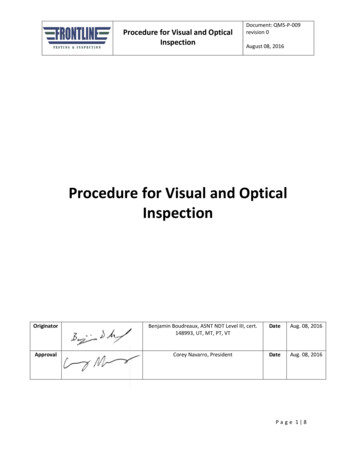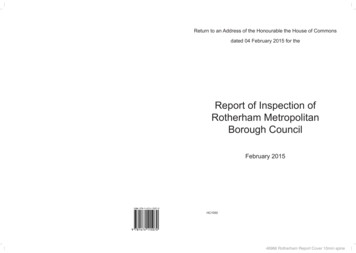
Transcription
Return to an Address of the Honourable the House of Commonsdated 04 February 2015 for theReport of Inspection ofRotherham MetropolitanBorough CouncilFebruary 2015HC105046966 Rotherham Report Cover 10mm spine
Return to an Address of the Honourable the House of Commonsdated 04 February 2015 for theReport of Inspection ofRotherham MetropolitanBorough CouncilAuthor: Louise Casey CBFebruary 2015HC1050
Crown copyright 2015This publication is licensed under the terms of the Open Government Licencev3.0 except where otherwise stated. To view this licence,visit e/version/3 or writeto the Information Policy Team, The National Archives, Kew, London TW94DU, or email: psi@nationalarchives.gsi.gov.uk.Where we have identified any third party copyright information you will need toobtain permission from the copyright holders concerned.This publication is available at www.gov.uk/government/publicationsAny enquiries regarding this publication should be sent to us at:Department for Communities and Local GovernmentFry building, 2 Marsham StreetLondon SW1P 4DFTelephone: 030 3444 0000Print ISBN 9781474115070Web ISBN 9781474115087ID 03021511 46966 02/15Printed on paper containing 75% recycled fibre content minimumPrinted in the UK by the Williams Lea Group on behalf of the Controller of HerMajesty’s Stationery Office
Overview and Executive SummaryForewordBackground and methodologyExecutive SummaryThe good people of Rotherham56912What happened in Rotherham and why it matters13What is Child Sexual Exploitation (CSE)?Child Sexual Exploitation: A picture in RotherhamResponse to Professor Jay’s Report: DenialAn unhealthy cultureThe Race IssueThe Role of Risky Business in tackling CSE in RotherhamChildren’s Services Failure/Children’s Social CareWhere were the police?Where were the rest of the council?Treatment of Victims15171928323742465354Rotherham Today621. Is the Council taking steps to address past weaknesses anddoes it have the capability to do so?62Background and judgementLeadership and GovernanceTop to bottom – translating political leadership into actionScrutiny and StandardsMember Standards of ConductSenior Management of the Council6264707577802. Is the council taking steps to address weaknesses in Children’sServices and its work on CSE and does it have the capacity tocontinue to do so?86Background (OFSTED inspection) and judgementScope of inspectionChildren’s Social Care ServicesChildren’s Social Care Services and CSEYoung people turning 18 years old86878889931
CSE numbers and analysisThe RMBC/SYP CSE Strategy‘Missing’The Offer to VictimsSummary949598991023. Did Rotherham take and continue to take sufficient steps toensure only ‘fit and proper persons’ are permitted to hold a taxilicence?103Background and JudgementLicensing at RMBC1031034. Taxis and Child Sexual Exploitation110Licensing Authority – denial that they knew of a CSE problemEvidence that the Licensing Authority knew of taxis and CSE as aproblemResponsible Authority meetingsRevocations and current practice1111121141165. Does the Council undertake sufficient liaisons with otheragencies?118Background and JudgementCommunity safety and tackling Child Sexual ExploitationAbduction noticesSouth Yorkshire Police1181261271276. Does the Council take appropriate action against staff guilty ofgross misconduct?130Background and JudgementAction post Jay reportDisciplinary, grievance and severance case filesSeverance payments and compromise agreementsSanctions, dismissals and the role of members1301301311321337. Does Rotherham cover up information and silence whistleblowers?134Background and JudgementCover up?1341362
Whistleblowing procedures and evidence reviewedStaff who blow the whistleAnnexesAnnex A: Serious Case Review into child S published in 2012Annex B: List of Rotherham Metropolitan Borough CouncilachievementsAnnex C: Findings from the Statement of AccountsAnnex D: Child Sexual Exploitation numbersAnnex E: Tools and powers available to tackle Child SexualExploitationAnnex F: GlossaryAnnex G: The Inspection Team3136137143145146148149152154
4
ForewordTerrible things happened in Rotherham and on a significant scale. Children weresexually exploited by men who came largely from the Pakistani HeritageCommunity. Not enough was done to acknowledge this, to stop it happening, to protectchildren, to support victims and to apprehend perpetrators.Upon arriving in Rotherham, these I thought were the uncontested facts. My job was toconduct an inspection and decide whether the Council was now fit for purpose.However this was not the situation I encountered when I reached Rotherham. Instead, Ifound a Council in denial. They denied that there had been a problem, or if there hadbeen, that it was as big as was said. If there was a problem they certainly were not told –it was someone else’s job. They were no worse than anyone else. They had wonawards. The media were out to get them.So this is why in making a judgement as to whether Rotherham Council is fit for purposetoday I have set it in the context of how it has behaved in the past and its reluctance todeal with past failings.I recognise that child sexual exploitation is hard to tackle. It is complex, sometimesthankless and very hard to get it right. But it is vital that public services face up to difficulttasks. However, Rotherham Council is a place where difficult problems are not alwaystackled as they should be. When faced with the solid findings contained in the report ithad itself commissioned by Professor Jay, it did not accept them. And without acceptingwhat happened and its role in it, it will be unable to move on and change.We must not lose sight of what the failures in Rotherham have meant in practice;victims have been hurt and remain without justice, the Pakistani Heritage Communityhas been harmed by association , as have individual social workers, police officers, taxidrivers and other hard working people in the Council, voluntary sectors and the town ofRotherham more broadly. It has also harmed public services because what happened inRotherham does not represent its values - of putting the needs of the most vulnerablealways at its centre.I want to be clear that the responsibility for the abuse that took place in Rotherham liesfirmly with the vile perpetrators, many of whom have not yet faced justice for what theyhave done. I hope that this will shortly be rectified. But in its actions, the conclusion that Ihave reluctantly reached is that both today and in the past, Rotherham has at timestaken more care of its reputation than it has its of its most needy.Child abuse and exploitation happens all over the country, but Rotherham is different inthat it was repeatedly told by its own youth service what was happening and it chose,not only to not act, but to close that service down. This is important because it points tohow it has dealt with uncomfortable truths put before it. However, I propose that thisreport is one uncomfortable truth that will not be ignored, but that Rotherham Council willuse it to embrace the change so sorely needed and ensure that from here it get itspriorities right.Louise Casey CBJanuary 20155
Background and methodologyProfessor Alexis Jay’s Independent Inquiry into Child Sexual Exploitation inRotherham was commissioned by Rotherham Metropolitan Borough Council inOctober 2013 and published on 26th August 2014. Covering the periods of 19972009 and 2009 - 2013, it looked at how Rotherham Metropolitan Borough Council’s(RMBC) Children’s Services dealt with child sexual exploitation cases.The report found evidence of sexual exploitation of at least 1400 children inRotherham over this period. The majority of the perpetrators were described as‘Asian’ by victims. Professor Jay found there was a “collective failure” by both theCouncil and police to stop the abuse.A Best Value authority is under a general Duty of Best Value to “make arrangementsto secure continuous improvement in the way in which its functions are exercised,having regard to a combination of economy, efficiency and effectiveness.”1The Secretary of State may appoint a person to carry out an inspection of a specifiedbest value authority's compliance with the requirements of this duty in relation tospecified functions.On the 10th September 2014, the Secretary of State appointed Louise Casey CBunder section 10 of the Local Government Act 1999 to carry out an inspection of thecompliance of Rotherham Metropolitan Borough Council with the requirements ofPart 1 of that Act, in relation to the Council’s exercise of its functions on governance,children and young people, and taxi and private hire licensing.In undertaking this inspection, Louise Casey CB was directed to consider:In exercising its functions on governance, children and young people, and taxi andprivate hire licensing, whether the local authority: 1allows for adequate scrutiny by Councillors;covers up information, and whether ‘whistle-blowers’ are silenced;took and continues to take appropriate action against staff guilty of grossmisconduct;was and continues to be subject to institutionalised political correctness,affecting its decision-making on sensitive issues;undertook and continues to undertake sufficient liaisons with other agencies,particularly the police, local health partners, and the safeguarding board;Department for Communities and Local Government, Best Value Statutory Guidance, 20116
took and continues to take sufficient steps to ensure only ‘fit and properpersons’ are permitted to hold a taxi licence; andis now taking steps to address effectively past and current weaknesses orshortcomings in the exercise of its functions, and has the capacity to continueto do so. Louise Casey CB was appointed as lead Inspector but as the statute allows, theSecretary of State appointed on her recommendation, Assistant Inspectors to ensurethat she had all the required skills and experience available to her to fulfil her remit.Louise Casey CB began her inspection on the 1st October 2014.In total the inspection team carried out over 200 meetings with: -Victims and their familiesWhistle-blowersConcerned members of the publicCurrent and former Cabinet MembersCurrent and past CouncillorsCurrent and past senior officersThe Monitoring OfficerHeads of SafeguardingFormer Directors of Children’s ServicesCurrent and past staff in Children’s ServicesManagers and staff in taxi licensingExternal auditorsOther local interested partiesRepresentatives from the following partners:Apna HaqBarnsley and Rotherham Chamber of CommerceCouncil of MosquesGROWLearners FirstLocal Safeguarding Children’s BoardRotherham Clinical Commissioning GroupRotherham Diversity ForumRotherham Ethnic Minority AllianceRotherham NHS TrustRotherham, Doncaster and South Humber Mental Health Trust (RDaSH)Safe @ LastSchools (x 2)Senior partners who have now left RotherhamSouth Yorkshire Fire and Rescue AuthoritySouth Yorkshire Police7
-Voluntary Action RotherhamInspectors met with over 30 representatives from the Rotherham Partnership,representatives from the Youth Cabinet, and from the community sector as facilitatedand invited by Voluntary Action Rotherham.The inspection also reviewed documentary evidence, sampled cases and processesand observed practice, including: Approximately 320 requests for documents totalling up to 7000 documentsand information68 past and current cases in Children’s Services19 staff case files22 taxi licensing casesReviewing policies, procedures and practicesThe Inspection team is very grateful for the cooperation of the management andsupport staff of the current Council in helping the facilitation of the inspection. Wewere treated courteously at all times. The team is also grateful that all current andformer staff that we approached including frontline workers, managers, Directors andMembers agreed to be interviewed. Two people declined – former Leader, RogerStone and former Police and Crime Commissioner, Shaun Wright.8
EXECUTIVE SUMMARYRotherham Metropolitan Borough Council is not fit for purpose. It is failing in its legalobligation to secure continuous improvement in the way in which it exercises itsfunctions. In particular, it is failing in its duties to protect vulnerable children andyoung people from harm.This inspection revealed past and present failures to accept, understand and combatthe issue of Child Sexual Exploitation (CSE), resulting in a lack of support for victimsand insufficient action against known perpetrators.The Council’s culture is unhealthy: bullying, sexism, suppression and misplaced‘political correctness’ have cemented its failures. The Council is currently incapableof tackling its weaknesses, without a sustained intervention.On 26th August 2014 Professor Alexis Jay published an Independent Inquiry intoChild Sexual Exploitation in Rotherham. The report, commissioned by RMBC as areview of its own practices, concluded that over 1400 children had been sexuallyexploited in Rotherham between 1997 and 2013. The vast majority of theperpetrators were said to be ‘Asian’ men.In response, on 10th September 2014, the Secretary of State for Communities andLocal Government appointed Louise Casey CB to carry out an inspection ofRotherham Metropolitan Borough Council (RMBC) under section 10 of the LocalGovernment Act 1999. The inspection would assess the Council’s compliance withthe requirements of Part 1 of that Act, considering leadership and governance,scrutiny, services for children and young people, taxi and private hire licensing, andwhether the council ‘covers up’ information.The inspection team reviewed approximately 7000 documents, looked in detail atcase files and met with over 200 people, including current and former staff, councilMembers, partners, victims and parents.Our investigations revealed: a council in denial about serious and on-going safeguarding failuresan archaic culture of sexism, bullying and discomfort around racefailure to address past weaknesses, in particular in Children’s Social Careweak and ineffective arrangements for taxi licensing which leave the public atriskineffective leadership and management, including political leadershipno shared vision, a partial management team and ineffective liaisons withpartners9
a culture of covering up uncomfortable truths, silencing whistle-blowers andpaying off staff rather than dealing with difficult issuesDespite Professor Jay’s findings, which we fully endorse, and substantial quantitiesof information available within the Council, RMBC demonstrates a resolute denial ofwhat has happened in the borough. This took several forms – notable in theirrecurrence – including dismissal of Professor Jay’s findings, denial of knowledge ofthe ‘scale and scope’ of CSE, blaming others, and denial that CSE remains a seriousproblem in present day Rotherham. Whilst the appointments of a Children’sCommissioner and interim Chief Executive (CE) have undoubtedly been beneficial,changes in the senior management team alone will not be enough to shift things on.Interviews with staff and Members of RMBC highlighted a pervading culture ofsexism, bullying and silencing debate. The issue of race is contentious, with staff andMembers lacking the confidence to tackle difficult issues for fear of being seen asracist or upsetting community cohesion. By failing to take action against thePakistani heritage male perpetrators of CSE in the borough, the Council hasinadvertently fuelled the far right and allowed racial tensions to grow. It has done agreat disservice to the Pakistani heritage community and the good people ofRotherham as a result.We have concluded that RMBC does not have strong enough political andmanagerial leadership to guide the borough out of its present difficulties and put itback on a path to success.RMBC’s Children’s Services are failing, with a lack of clarity over priorities,repeatedly missed deadlines for the assessment of children in need of care andprotection, poor decision-making, drift and delay. The dedicated CSE team is poorlydirected, suffers from excessive case loads, and an inability to share informationbetween agencies.Perpetrators are identified, but too often little or no action is taken to stop or evendisrupt their activities and protect children from harm. One of the most importantpartners is South Yorkshire Police, with whom inspectors expected to find a robustand equal relationship. Instead, RMBC demonstrated an excessive deference topolice assurances and a failure to recognise their own role in pursuing perpetrators.This prevented the use of council powers to tackle perpetrators and a lack of scrutinyover the police’s actions – actions which inspectors would also call into question.Partnership working is ineffective. The structures are overly-complicated and do notdrive action. Partners are critical that the Council is not providing a lead in thesetroubled times for the town.10
The Council does not use inspection to learn and improve. Members are overlyreliant on officers and do not challenge tenaciously enough to ensure improvements.Meeting and action plans are numerous but unproductive, with a tendency towardsinertia.Some Members have not set and modelled the high standards expected of those inpublic life. Historic concerns around conduct have not been effectively tackled.RMBC has a culture of suppressing bad news and ignoring difficult issues. Thisculture is deep-rooted; RMBC goes to some length to cover up information and tosilence whistle-blowers.RMBC needs a fresh start.11
The good people of Rotherham and beyondInspectors found many committed, hardworking and dedicated staff working forRotherham Council including frontline staff and social workers. Inspectorsacknowledge that it cannot be easy for them to go into work every day intending todo a good job, amid a stream of criticism of their organisation, let alone marchesfrom the English Defence League (EDL) in their town centre.During the course of the inspection we came upon various individuals andorganisations who were worthy of particular mention and praise by the inspection,however we were conscious that to list them in this report may cause themdifficulties either professionally or personally.However, our sincere thanks must go to two particular groups of people who spoketo us under the most testing circumstances; the individuals and whistle-blowers whocame forward bravely to give evidence to us and of course, the victims of childsexual exploitation and their families who courageously recounted the awful thingsthat happened to them.12
WHAT HAPPENED IN ROTHERHAM AND WHY IT MATTERS“I think it’s quite sad, not just what happened to my daughter but how the system hasresponded. I was brought up to believe that when something bad happened, you toldthe police or social services and they help you - something would be done about it that isn’t what happened.” A victim’s fatherProfessor Alexis Jay’s report in August 2014 set out a history of child sexualexploitation (CSE) in Rotherham over 16 years. The Council commissioned thereport following mounting concerns from outside bodies about CSE in the town.Over 2012 and 2013, Rotherham had been on the front page of The Timesnewspaper. RMBC’s Chief Executive and Strategic Director of Children’s Serviceshad appeared before the Home Affairs Select Committee as had the police andCrime Commissioner and Chief Constable of South Yorkshire Police. The thenPolice and Crime Commissioner had requested three reports into the poor handlingof CSE by South Yorkshire Police and sexual exploitation in Yorkshire and the NorthWest was a live issue.The Home Affairs Select Committee report on 5th June 2013 on CSE criticisedRMBC and South Yorkshire Police.“Both Rochdale and Rotherham Councils were inexcusably slow to realise that thewidespread, organised sexual abuse of children, many of them in the care of thelocal authority, was taking place on their doorstep. This is due in large part to awoeful lack of professional curiosity or indifference.”2“We have heard evidence that South Yorkshire Police Force have previously letdown victims of localised grooming and child sexual exploitation— as a result, wewould expect the force be striving to redeem their reputation.”3In August 2013, The Times ran a story regarding the Deputy Leader of RotherhamCouncil as having been involved some years previously in the handover of a girl topolice who had been a victim of CSE.In September 2013, the Council commissioned the Jay Report and the long standingcouncil Leader apologised to the “young people and their families [who] have beenbadly let down by the Council in the past.”Professor Alexis Jay was commissioned to establish what had happened inRotherham. Her review’s terms of reference were very wide ranging. She was to lookback at the past and see whether and how things had changed today.23Home Affairs Committee: Child sexual exploitation and the response to localised grooming. Volume I., p. 27Ibid., p. 3613
Commissioning Professor Jay to come in and look at this very difficult issueappeared at face value to be a brave action by the Council. She spent over eightmonths in Rotherham and the published report was the result of her relentless hardwork. The Leader of the Council immediately stepped down.The commissioning of the report and later, the resignation of the Leader, are actionssuggestive of a council that: accepts the need to examine its pastaccepts that it may have got things wronghas an intention to put right those wrongswants to challenge its shortcomingsand wants to ensure that nothing like this would happen againExcept that’s not the Rotherham we found upon arrival for this inspection or haveseen since.14
WHAT IS CHILD SEXUAL EXPLOITATION?“I want you all to.look for the child that is unhappy, that doesn't want to be at school,that has no friends, that seems to be going out an awful lot, that could be drivingaround in cars, has more than one mobile, that has an attitude, that seems to have alot of boyfriends and ask yourself, is this a victim of CSE?” From a presentationgiven by a victim of CSEIn order to look at how effectively RMBC was tackling CSE, Inspectors needed tohave a working understanding of the issue. It is, undoubtedly, a very difficult problemfor public services to deal with and there are many complexities involved. But thatshould never be used as an excuse for inaction.CSE is a form of child abuse in which perpetrators develop total control over theirvictims. It starts with a grooming process, in which victims are showered with giftsand attention. They are treated like adults, for example, by being taken out in cars.The young person can believe that the perpetrator is their boyfriend and that they arein love. This is a powerful thing, especially for young children or young people whomay have difficult family backgrounds and crave love and attention. As a result, theydo not complain. The grooming process isolates the victim from friends and family.At some point, drugs, alcohol and sex may be introduced. They are forced not onlyto have sex with their abuser but sometimes other men too. This is coupled withmore overt coercion, threats and violence. By now, victims may be dependent ondrugs and alcohol, afraid of their abuser, isolated from their family and scared thatthey will not be believed or that worse may happen to them or their families if theymake a complaint.The consequences of CSE are appalling. Victims suffer from suicidal feelings andoften self-harm. Many become pregnant. Some have to manage the emotionalconsequences of miscarriages and abortions while others have children that they areunable to parent appropriately. The abuse and violence continues to affect victimsinto adulthood. Many enter violent and abusive relationships. Many suffer poormental health and addiction.The predators often target children with difficult backgrounds, including those in care,who are particularly vulnerable to grooming. But they are also sometimes able toexploit those from stable backgrounds. That families, despite their very best efforts,are unable to prevent the abuse reflects the power of the abusers and the degree ofcontrol they exert.Tackling CSE is incredibly difficult. No one should underestimate this. It requiresspotting the signs, helping young people to recognise their experience as abuse and15
getting them to trust public services instead of their abusers, often in the face ofserious threats.Then it requires supporting victims through the criminal justice system, where theymay have to ‘relive’ the experience again. There are challenges in gaining sufficientevidence for prosecution. When child sexual exploitation is happening on the scalethat it did in Rotherham, there will be multiple perpetrators and victims, andestablishing a complete picture by fully appreciating all the links and connections, willbe difficult.CSE embodies issues which are incredibly difficult to deal with. First, serious sexualviolence. Second, victims who may reject help. The grooming involved is a form ofbrainwashing, which means that even though the victims are being abusedemotionally, physically and sexually, they can be loyal to their abuser, rather thantheir family or social worker. Third, the age of the victims involved. Teenage sexualityis a confusing issue for adults and adolescents alike. Many of these girls are on thecusp of adulthood and want to behave like adults but do not yet have the emotionalcapacity to do so. Abusers exploit this uncertainty.Many local authorities and other services are struggling with this complex crime andas the OFSTED report4 on CSE found few have got it right. Given all the difficultiesinvolved, this is not surprising. But CSE is a horrifying and brutal crime withdevastating consequences for victims and their families. Councils and their partnersmust not give up on them.Tackling CSE effectively requires a council and its partners to mobilise their servicesand powers together. The Council has a duty to safeguard the victims. It alsogoverns the landscape in which CSE is played out including many schools, carehomes, parks, taxis and take away food shops. Councils have powers of licensingand regulation which can be used to disrupt illegal activity in these places and keepthe community safe. This is in addition to the duties and powers of the police.We accept all these challenges make tacking exploitation difficult. But they cannot beused as excuses. Fundamentally, this is about the rape and abuse of children byadults. Victims cannot be abandoned to their abusers. Authorities cannot claim theyare powerless to act.4OFSTED, Sexual Exploitation of Children: OFSTED Thematic Report, 19 November 201416
CHILD SEXUAL EXPLOITATION – A PICTURE IN ROTHERHAMFrom a review of case files and files on police operations, information from RiskyBusiness5, and from victims, parents and professionals, it is possible to present apicture of sexual exploitation in Rotherham as it developed.Vulnerable girls, most frequently those with difficult family backgrounds, and or ahistory of being in care, were particularly affected. Girls were as young as nine whenthey began to be exploited.Perpetrators in Rotherham appear to have been largely from the Pakistani heritageCommunity. Perpetrators used what is known as ‘street grooming’ to prepare theirvictims for exploitation.Some of the exploitation was connected to a nucleus of men or gangs of men whowere already involved in criminal activity, including supplying drugs, trafficking,sexual exploitation and prostitution across Rotherham and South Yorkshire.There were other less organised groups of predatory men who would seek out younggirls and form emotional bonds with them. Girls would be contacted initially by phoneor by text, often by a young adult male who they had met on the street, or in theshopping centre or park. These younger men who carried out the grooming weren’talways the abuser. Girls were misled into believing these men were their boyfriends.Once their trust had been gained, the girls were vulnerable to sexual abuse andwere even shared and passed around other men or groups of men. Victims wouldstart to receive phone calls from numerous other males wishing to meet them andengage in sexual acts, and be pressured by their ‘boyfriend’ into doing what wasasked. They would be picked up in taxis and cars, from schools or children’s homesor from their own family homes. Girls would go missing from home regularly and forextended periods. They would be taken to restaurants or to other properties wherethey would have sex with one or more men.They were given drugs and alcohol which they then had to ‘pay for’ in sex. If they didnot concur, they would be subject to rape, multiple rapes, rape with physicalviolence, and threatened with weapons.Perpetrators in Rotherham generated real fear. They were often perceived to beconnected to other forms of criminality and violence and victims and their familieswere too frightened to speak and did not feel the police could protect them. Theywere threatened and intimidated into silence. Victims and their families speak ofgroups of men in cars waiting outside their house or outside children’s homes,5A youth project – detail given later, in Section 1, of this report.17
sometimes attempting to break in. Phone calls and texted threats, including threatsto rape other members of the family, were described to us.Fear was also evident at times among professionals, teachers, hostel workers andyouth workers.Some children needed to be placed out of the area and others in secure units fortheir own protection. The grooming was so effective that, despite the abuse andviolence, victims would continue to attempt to return to their abusers.Other patterns in Rotherham involved lone offenders targeting under 16’s. Adultmales, and on occasion females, with
Professor Alexis Jay s Independent Inquiry into Child Sexual Exploitation in Rotherham was commissioned by Rotherham Metropolitan Borough Council in October 2013 and published on 26 th August 2014. Covering the periods of 1997- 2009 and 2009 - 2013, it looked at how Rotherham Metr opolitan Borough Council s
